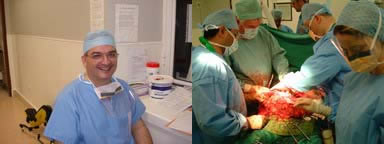 |
 |
|
|
All images, illustrations & flash animation are copyrighted to Deya Marzouk, unless stated otherwise. Copy is prohibited without written permission. Innovative techniques mentioned in this web site were all devised by Deya Marzouk. Please Credit Deya Marzouk if any material is copied from here (with prior permission only) |
This is a term that denotes that one part of the bowel will slide inside another part of the bowel so that there will be a tube inside a tube.
When this happens in the rectum it is called internal rectal intussusception
rectal intussusception can be broadly divided into high type (recto rectal) and low type (recto anal).
This is not always clear. Intussusception (high type) can be found in asymptomatic normal volunteers undergoing defaecation proctography. However, the low type is not uncommonly associated with obstructed defaecatory symptoms. In many patients there is an associated rectocoele as well
This is usually difficult to tell. Defaecation proctography may suggest that intussusception may descend low enough to impede further defaecation or may suggest that a large functional rectocoele may actually contribute more to the difficulties with evacuation.
Careful patient history and examination likewise may shed light on whether both intussusception and rectocoele contribute to the difficulty with evacuation or whether one is more important. At the end the experienced coloproctologist has to make an informed judgment on what is more important and thus recommend a particular course of treatment
Click on the relevant buttons on the navigation panel to see the Flash animation above to understand intussusception & its treatment
Symptoms
Diagnosis
Clinical diagnosis
Dynamic proctography
Associated pelvic floor disorders
Physiology
Treatment
Conservative
Understanding
Stop straining
Surgical treatment of obstructive defaecation is still in its infancy. The number of studies evaluating different approaches is small and the number of patients treated in each series is also small. Pioneering surgeons in the field hold strong views on one approach or another, without strong evidence in most cases. Patients need to be made aware of the different options and should be involved fully in the discussion prior to surgery, emphasizing that these procedures may improve, but not necessarily cure obstructive defaecatory symptoms altogether. It is also very important to emphasize what is being treated here, which is an anatomical abnormality that appear to interfere with the mechanics of defaecation. Surgery can not be expected to change disordered sensation and thus may not
This is possible in patients with really low recto anal intussusception, but it is a difficult procedure to perform. I had a reasonable success with it, with about 60% of patients reporting improvement in symptoms
Abdominal rectopexy alone has
Abdominal rectopexy & anterior resection (sometimes with colposuspension) is my current preferred option and most of these can be done laparoscopically. This deals directly with the internally prolapsed rectum, can treat enterococeles simultaneously by lifting the pouch of Douglas upwards and can also treat vaginal vault prolapse by incorporating colpopexy. It can be done using sutures or a mesh and in most patients addition of segmental sigmoid resection (high anterior resection), prevent acute bowel angulation afterwards, which may cause obstructive defaecation symptoms
 |
 |
|